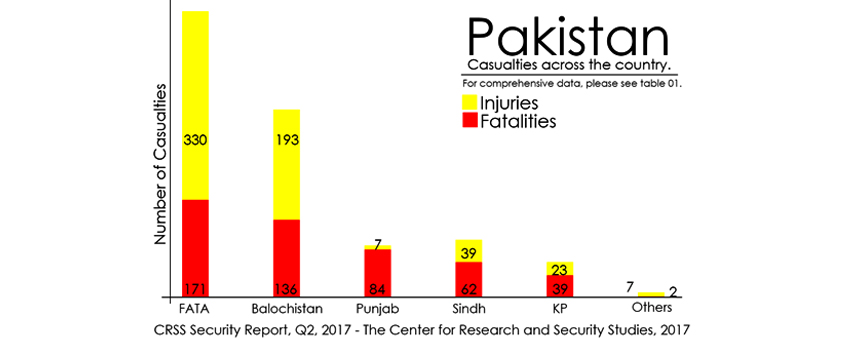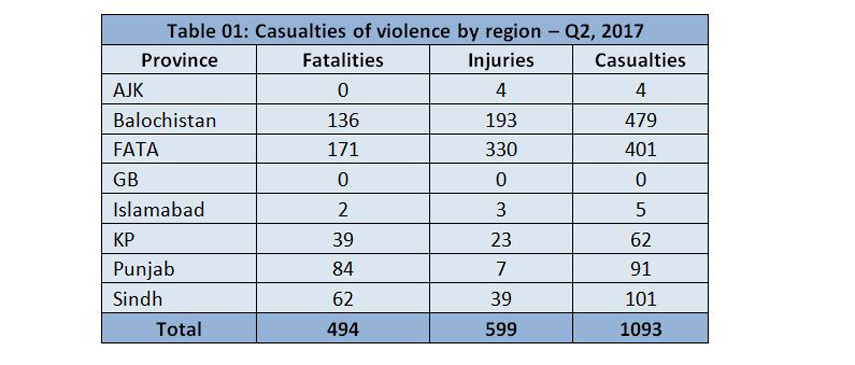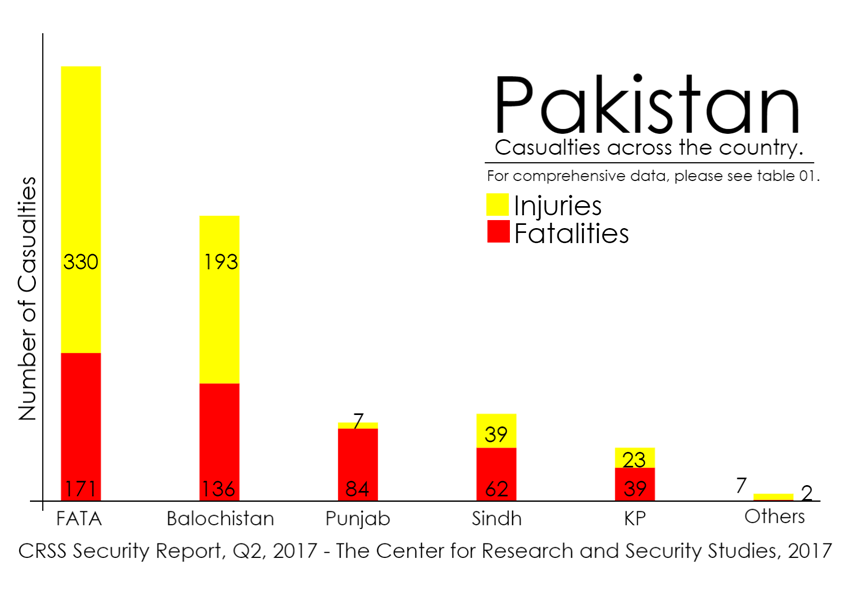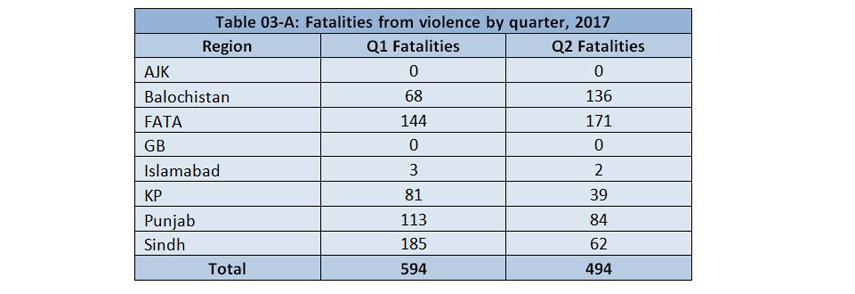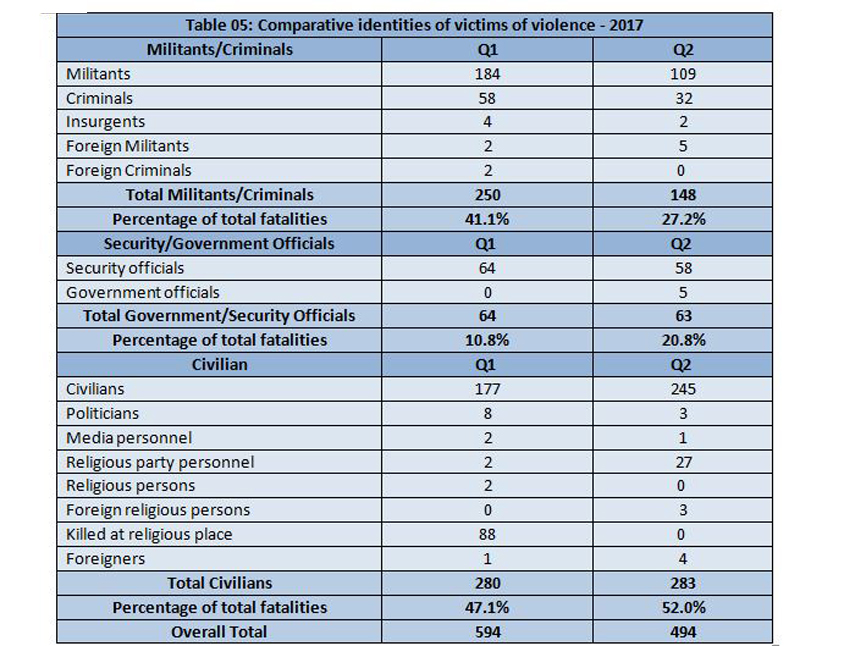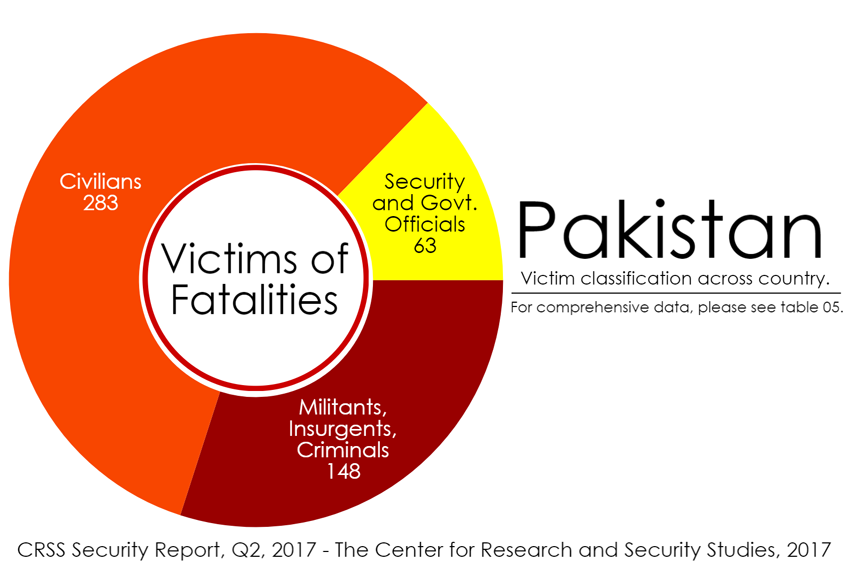Executive Summary:
The overall security situation in the country improved considerably during this quarter as the number of fatalities dropped. However, security challenges remain multi-dimensional both domestically and along Pakistan’s borders. Violence along the border areas increased significantly and the militancy inside the country assumed a new dimension as they shifted their respective areas of operations and attacks. Most regions, such as the Federally Administered Tribal Areas (FATA), Khyber Pukhtunkhwa (KP), Balochistan and Punjab saw a reduction in the number of fatalities (compared to the same quarter last year), while Sindh saw a small rise in violence-related casualties.
Overall, Q2, 2017 (494) also saw a significant drop in violence-related fatalities over Q1, 2017 (594). However, within the overall reduction, the number of criminal and militant fatalities declined, whereas the number of security and government official and civilian fatalities increased. This is also indicative of the observed change in the terrorists’ overall strategy, as they shift their focus from soft targets to government and security officials and installations – very obvious from the overwhelming number of attacks on the state security apparatus.
To assess and evaluate what new challenges and threats are being faced by the country, this report draws on national print and electronic media sources. At the same time CRSS endeavors to ensure that the data is as accurate as possible within the available resources. However, it does not rule out errors and omissions, which are always a possibility in such public-source statistical work. Such mistakes, nevertheless, do not grossly affect the overall outcome and conclusions of this report. It must also be said that this work cannot take into account incidents of violence-related fatalities and casualties that go unreported.
Readers can approach CRSS for information related to this report. Alternately, you may send your queries to mail@crss.pk, directly to Mohammad Nafees, Senior Research Fellow, CRSS – the author of the report (mohammad.nafees@yahoo.com), or Zeeshan Salahuddin, Senior Research Fellow, CRSS.
As many as 1,163 persons were the victims of violence in the country during Q2, 2017 (April-June) of which 494 were the fatalities and 599 injuries. The border region of FATA registered the highest number of fatalities followed by Balochistan, Punjab, Sindh and KP – (refer table 01).
India and Pakistan lost 41 souls – 19 in Indian Kashmir and 22 in Pakistani Kashmir areas – in border skirmishes/attacks (refer table 02). The civilian casualties were higher in Pakistan (10) than India (6). The cross border attacks by the armed forces of other neighboring countries also caused fatalities in Balochistan during this quarter. 21 persons lost their lives in Killa Abdullah (Chaman border area) because of the shelling of Afghan forces, while one person was killed in Panjgur when Iranian forces resorted to shelling in Pakistan.

For the first time in the last four years, Punjab recorded a higher number of fatalities from violence than Sindh and KP. However, the least populated regions of the country, FATA and Balochistan, continue to take the brunt of violence-related casualties (refer table 03-A).
Comparative monthly data shows a 16% drop in fatalities from violence during Q2, when compared to Q1 (refer table 03-B).
The data on methods of violence and counter-violence shows decline in major forms of violence with the exception of bomb explosions, gunning down of the targeted victims, and bomb victims succumbing to their injuries. The fatalities from suicide attacks reduced by nearly 40% when compared to Q1, 2017 (refer table 04).
The fatalities of militants and criminals dropped significantly this quarter. From 250 fatalities of outlaws in Q1, the number went down to 148, which accounts for 27% of the total fatalities from violence during Q2. The percentage of the fatalities of civilians, security and government officials was 73%, up from 58% recorded in Q1 (refer table 05). In other words, while the overall fatalities have dropped, militants and criminals have benefited from this change the most.

